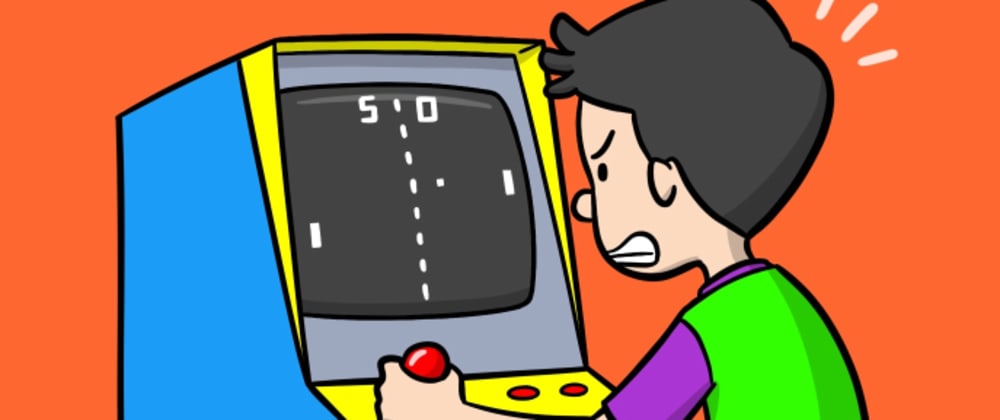Intro
Pong is one of the earliest arcade games. As a successful game, it spawns countless of clones and derivatives on arcade machines, video consoles and personal computers.
By following this tutorial you’ll learn how to implement a clone of this popular game using JavaScript.
Feel free to further customize and skin the game and then share it with your family and friends.
What do you need?
To run the code in this article you don’t need to install anything on your local computer.
Just open the online JavaScript playground from codeguppy.com/code.html and copy and paste the following code in the integrated editor.
When ready, press the “Play” button to run the code.
Source code
const paddleSpeed = 5;
const ballSpeed = 5;
var computerPaddleSpeed = 1;
var userPaddle = createPaddle(50, 'left');
var computerPaddle = createPaddle(50, 'right');
var ball = createBall();
var scoreUser = 0;
var scoreComputer = 0;
function loop()
{
clear();
drawScene();
readKeys();
updateComputerPaddle();
drawPaddles();
updateBall();
drawBall();
checkCollision();
checkOut();
displayStats();
displayInstructions();
}
function checkOut()
{
if (ball.x < 0)
{
scoreComputer++;
resetGame();
}
else if (ball.x > width)
{
scoreUser++;
// if the user wins, computer will increase the paddle speed
// so it can be harder to beat next time
computerPaddleSpeed += random(0.75);
resetGame();
}
}
function updateComputerPaddle()
{
if (ball.dx == 1)
{
// find y where the ball will hit
var y = ball.slope * (computerPaddle.x - ball.x1) + ball.y1;
// calculate distance between computer paddle and where the ball will hit
var dy = (y - computerPaddle.y - computerPaddle.w / 2);
// calculate the dy that should be applied to the computer paddle to intercept the ball
dy = dy / ( (computerPaddle.x - ball.x) / ballSpeed );
// computer cannot move faster than the setting...
dy = constrain(dy, -computerPaddleSpeed, computerPaddleSpeed);
computerPaddle.y += dy;
}
}
function updateBall()
{
if (!ball.inMotion)
return;
ball.x += ball.dx * ballSpeed;
ball.y = ball.slope * (ball.x - ball.x1) + ball.y1;
}
function checkCollision()
{
hitBall(userPaddle);
hitBall(computerPaddle);
}
function hitBall(paddle)
{
if (collisionCircleRect(ball.x, ball.y, ball.r, paddle.x, paddle.y, paddle.h, paddle.w))
{
// workaround: move the ball in front of the paddle
ball.x = paddle.x + -1 * ball.dx * (paddle.h + ballSpeed);
// pick a new random slope
pickSlope();
// reverse ball direction
ball.dx *= -1;
}
}
function pickSlope()
{
// pick a random point on the oposite wall
ball.x2 = ball.dx < 0 ? width : 0;
ball.y2 = random(ball.r, height - ball.r);
// current ball position
ball.x1 = ball.x;
ball.y1 = ball.y;
// calculate the slope of the line that the ball need to use to hit the point
ball.slope = (ball.y2 - ball.y) / (ball.x2 - ball.x);
}
function displayStats()
{
push();
noStroke();
fill(0);
textSize(24);
textAlign(LEFT, CENTER);
text(scoreUser, 10, 20);
textAlign(RIGHT, CENTER);
text(scoreComputer, width - 10, 20);
pop();
}
function displayInstructions()
{
if (ball.inMotion)
return;
push();
fill('white');
rect(200, 450, 400, 100);
fill(0);
noStroke();
textSize(24);
textAlign(CENTER, CENTER);
text('Press SPACE to launch the ball', 400, 500);
textSize(14);
text('Use Q and A to move the paddle', 400, 530);
pop();
}
function drawBall()
{
strokeWeight(1);
fill('green');
circle(ball.x, ball.y, ball.r);
}
function drawScene()
{
strokeWeight(3);
noFill();
rect(0, 0, width - 1, height - 1);
line(width / 2, 0, width / 2, height);
fill('white');
circle(width / 2, height / 2, 50);
}
function readKeys()
{
if (keyIsDown(81) && userPaddle.y >= paddleSpeed ) // Q
{
userPaddle.y -= paddleSpeed;
}
else if (keyIsDown(65) && userPaddle.y < height - userPaddle.w - paddleSpeed) // A
{
userPaddle.y += paddleSpeed;
}
else if (keyIsDown(32)) // SPACE
{
launchBall();
}
}
function launchBall()
{
if (ball.inMotion)
return;
// launch the ball randomly to right(1) or left(-1)
ball.dx = random([1, -1]);
pickSlope();
ball.inMotion = true;
}
function drawPaddles()
{
strokeWeight(1);
fill('Teal');
rect(userPaddle.x, userPaddle.y, userPaddle.h, userPaddle.w);
rect(computerPaddle.x, computerPaddle.y, computerPaddle.h, computerPaddle.w);
}
function createPaddle(w, where)
{
var paddle = { w : w,
h : 10,
y : (height - w) / 2,
};
paddle.x = where == 'left' ? 10 : width - paddle.h - 10;
return paddle;
}
function createBall()
{
var ball = {
x : width / 2,
y : height / 2,
r : 10,
slope : 0,
dx : 0,
inMotion : false
};
return ball;
}
function resetGame()
{
ball.x = width / 2;
ball.y = height / 2,
ball.dx = 0;
ball.inMotion = false;
userPaddle.y = (height - userPaddle.w) / 2;
computerPaddle.y = (height - computerPaddle.w) / 2;
}
Feedback
If you liked the article, please follow @codeguppy on Twitter and / or visit codeguppy.com for more tutorials and projects.
Also, if you want to extend this article with detailed instructions explaing how to build the program step by step, please leave feedback in the comments.








Top comments (0)